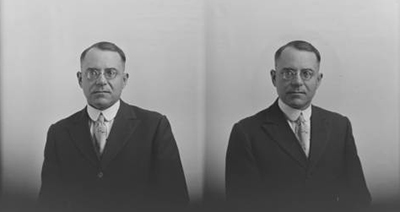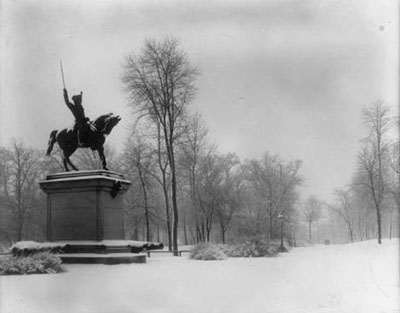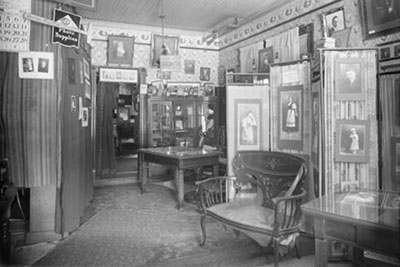Introduction
By John Gurda
More than two hundred thousand Milwaukeeans trace their family roots to Poland. That is enough to make Milwaukee one of the capital cities of Polish America, a place where Pope John Paul II is revered, the polka is mastered at an early age, and you’re never far from cold beer and good kielbasa. Milwaukee’s Polonia (Polish American community) is larger than those in Cleveland, Buffalo, and Pittsburgh, and in proportional terms, it is on par with the colonies in Chicago and Detroit. Within metropolitan Milwaukee, only residents of German or African ancestry make up a larger percentage of the population.
Roman Kwasniewski photographed this distinctive community during a formative period in its development. He was most active in the years between World War I and World War II, particularly the 1920s and 1930s—a time of head-spinning economic prosperity and then economic collapse, of growing ethnic maturity that gave way to systemic social change. What Kwasniewski created, apparently without forethought, was a community portrait that is uncommonly complete, technically superb, and compelling in its humanity. Few neighborhoods in America, ethnic or otherwise, have been chronicled in such loving detail.

The community that appears in Kwasniewski’s prints predates his arrival by several decades. In the half century following 1870, more than 3.5 million Poles left Europe for the United States. Most were impoverished peasants facing diminished prospects at home and looking across the ocean for greater opportunities, particularly in the rapidly industrializing cities of the northern United States. There was a political dimension to their movement as well. Once a major power in central Europe, the Polish state had ceased to exist in 1795, when Russia, Prussia, and Austria carved it into three dependent territories. Conditions in western, or German, Poland—the ancestral home of more than 80 percent of Milwaukee’s Poles—were especially harsh. Military conscription and cultural repression made emigration an obvious choice.
A significant number of America’s Polish newcomers came to Milwaukee, and they came unusually early. In 1866, only two decades after the city was chartered, thirty Polish families organized the parish of St. Stanislaus. It was the first Polish Catholic congregation in urban America, and it was followed two years later by the nation’s first Polish Catholic school. The parish’s original home was a modest brick building on the near South Side, purchased (for $4,000) from a group of German Lutherans. In 1872 the immigrants built a church of their own design on nearby Mitchell Street. The twin-spired Gothic landmark is still the center of parish life.
With “St. Stan’s” as its anchor, Milwaukee’s Polonia continued to make history. In 1874 the Kosciuszko Guard was commissioned as America’s first Polish military company. In 1878 a saloon keeper named August Rudzinski became the nation’s first Polish American to win municipal office, taking a seat on the Milwaukee County Board. In 1888 the irrepressible Michael Kruszka launched the Kuryer Polski, a newspaper that proved to be the country’s first successful Polish daily.
Polish Milwaukeeans set any number of precedents, but their status as pioneers did not mask the poverty that most families endured. Although they arrived early, the immigrants came to a city whose pecking order was firmly established. Yankees—transplants from New York and New England—exercised an influence entirely out of proportion to their numbers, even though they were vastly outnumbered by German-speaking residents. Milwaukee, in fact, was already the most German city in America, and Teutonic newcomers were shaping its cultural and economic life decisively. The Irish, despite their poverty, were a potent force in local politics. Polish immigrants, after depleting their reserves in crossing to America, had little choice but to start at the bottom.
What that meant, in the later nineteenth century, was jobs in local industries—the foundries, tanneries, packing houses, iron mills, and increasingly, manufacturing plants that were driving Milwaukee’s economy. The work was generally hard and often hazardous, not to mention poorly compensated. A laborer of the 1880s could expect to earn only one dollar for a standard twelve-hour day—roughly $1.50 an hour in modern terms—with no vacation, no health insurance, and no pension.
Although their economic struggles were unending, the Polish immigrants did something that took their neighbors by surprise: they built homes of their own. Throughout American urban history, the newest groups have generally occupied the oldest houses, settling in hand-me-down neighborhoods on the fringes of the nation’s downtowns. The Poles broke that unwritten law. “Usually the first money they can call their own is put into the purchase of a lot,” reported the Milwaukee Sentinel in 1874, “on which they mean to erect a house as soon as possible. They have a strong prejudice against paying rent.” Reflecting the Old World belief that land, not money, is the key to security, the immigrants bought lots that were painfully small by modern standards—only twenty-five or thirty feet wide—and covered them with simple frame cottages resting on cedar posts.

The result was an unusually dense settlement pattern that got even more dense with time. In Milwaukee and elsewhere Polish immigrants displayed a genius for additive architecture. As the years passed and finances permitted they used heavy jacks to lift the original cottages several feet off their foundations and then underpinned them with brick or block half-basements. Single-family homes became duplexes practically overnight. Known locally as Polish flats (or in the parlance of the building inspectors, English basement duplexes), the two-stage houses covered block after block on the city’s expanding periphery. In 1902 Milwaukee was one of the most densely built cities in the country, trailing only Boston and Baltimore, and its densest neighborhoods were those developed by Polish immigrants.
My grandmother’s family typified the trends. Mary Heft Gurda’s father died of tuberculosis when she was only nine, leaving her mother to raise six children on a washerwoman’s wages. What saved the family from ruin was the fact that they had five living units in the two buildings on their cramped South Fourteenth Street property. One (the smallest, of course) was for their own use; the others provided rental income. There was no shortage of playmates. When my grandmother was a girl, a total of twenty-seven children lived on her little lot—enough for three baseball teams!
Polish flats were most numerous on the South Side, particularly in the blocks south of Greenfield Avenue. That area was the heart of Milwaukee’s Polonia, accommodating at least three- fourths of its population. A second stronghold developed on the city’s East Side, near the intersection of Brady Street and Humboldt Avenue, where jobs in the tanneries, flour mills, and other industries lining the nearby Milwaukee River attracted workers. The neighborhood’s linchpin was St. Hedwig’s Church, established in 1871 as Milwaukee’s second Polish congregation. An entire community grew up literally in the shadow of St. Hedwig’s. When the East Side’s Polonia was filled to overflowing, younger families moved across the river and developed the neighborhood known today as Riverwest.
Milwaukee’s third Polish settlement was one of the most unusual in America. In the 1870s fishing families from the Kaszuby region on the Baltic seacoast began to settle on Jones Island, the windswept peninsula at the mouth of the Milwaukee River. German-speaking Pomeranians and a scattering of other groups joined the Kaszubs in making Jones Island the regional capital of commercial fishing. The islanders harvested two thousand tons in a good year, a mixed catch of trout, whitefish, perch, chubs, and sturgeon. The Lake Michigan fishery supported a community whose population peaked at sixteen hundred near the turn of the twentieth century. Jones Island was a picturesque jumble of fish sheds and drying reels at the water’s edge and jerry-built houses set on meandering dirt roads in the interior. (There were also eleven saloons on the island at one particularly wet point in its history.) While their countrymen across the river filed through the plant gates of the city’s major industries, the Kaszubs continued a way of life they had known for centuries in their homeland. Jones Island was the closest thing Milwaukee has ever known to a genuine urban village, and it lasted until the 1920s, when the city took the land for harbor facilities and a sewage- treatment plant.
The Polish flats on the mainland and the cottages of the Jones Island fisherfolk were undeniably modest; they reflected the best efforts of a group that could, for the time being, afford nothing better. But the modesty of Polish Milwaukee’s houses stood in stark contrast to the majesty of its churches. St. Stan’s was the mother parish of more than twenty Polish Catholic congregations, and their steeples stand as benchmarks in the outward expansion of the city’s Polonia. Viewed together, the churches are a distinguished ensemble. Despite their poverty, Polish immigrants showed a penchant for grand ecclesiastical architecture, and no church was more imposing than the Basilica of St. Josaphat. Built with materials salvaged from the Chicago Post Office, this Romanesque marvel was completed in 1901. The parish had nearly twelve thousand members at the time—probably the most of any congregation in the state, regardless of faith—and the church they built is still the city’s largest. But St. Josaphat was a parish of the poor. It took until 1925—nearly a quarter century—for the congregation to pay off its debt, and only then was work on the interior pushed to completion. In 1929 Pope Pius XI declared the church a basilica, the ecclesiastical equivalent of all-star status. St. Josaphat was only the third basilica in the country.
Completing such a glorious church in 1901, even without a finished interior, was a mark of institutional maturity, a clear signal that Milwaukee’s Polonia was here to stay. As immigrants kept crossing the ocean, the ranks of the community continued to swell. By 1906 there were nearly seventy thousand Polish Milwaukeeans—a number exceeded only by the Germans—and the Polish vote had become a decisive factor in local politics. The community’s fortunes were further bolstered by World War I. The conflict was disastrous for local German culture (sauerkraut was rechristened “liberty cabbage”), but the Allied victory was an unmixed blessing for expatriate Poles. In 1918 Poland became a free nation for the first time since 1795. Basking in the reflected light of a free homeland and growing slowly more prosperous in the freedom of America, Polish Milwaukeeans had much to celebrate.

It was at this point that Roman Kwasniewski entered the picture. Born in Chicago in 1886, Kwasniewski moved to Milwaukee with his parents as a child and stayed for the rest of his life. His father, Jozef, operated a printing business on Becher Street, near the heart of the South Side’s Polonia. Roman worked with him until 1913, when he opened the Park Studio on Lincoln Avenue near Tenth Street. Named for nearby Kosciuszko Park, the studio won a loyal following on the South Side. Kwasniewski typically worked with a 5×7 view camera that produced glass-plate negatives of remarkable clarity; most modern digital images look like pixelized mud by comparison. In 1916 the Park Studio moved to new quarters down the block, and Roman Kwasniewski remained in business there for the next thirty-one years.
Studio photography was the core of Kwasniewski’s business. Legions of South Siders posed before the obligatory Victorian backdrops in his studio, generally to mark important life passages: First Communions, confirmations, graduations, weddings, and anniversaries. But the photographer also took his camera into the community. Kwasniewski’s images are an exhaustive collection of the mundane, the celebratory, and the picturesque. If a new bridge opened or a new church was built, Kwasniewski was there. If a family wanted a permanent record of a backyard birthday party or a festive Christmas gathering, they called Kwasniewski. He was a fixture at grand openings and ground breakings, at pageants, plays, and parades. He captured masons at work, babies in carriages, corpses in caskets, foundry hands on the job, nuns in full habit, and soldiers going off to war. For literally thousands of families and organizations on the Polish South Side, Roman Kwasniewski was the photographer of choice for decades.
This was clearly a man who was deeply engaged in the world around him. In addition to the carefully crafted images he made for a living, Kwasniewski photographed snowstorms, cloud formations, rural scenes, and arrangements of leaves that he found interesting. Family history and photographic invention were other passions. In his free time the photographer took an active part in Polish fraternal societies, South Side business associations, and church and school groups. In perhaps his most surprising role, Kwasniewski was the agricultural editor of the Kuryer Polski.
But photography was the pursuit that defined Roman Kwasniewski for posterity. It is important to note that he was neither an artist nor a photojournalist but a photographer for hire. The vast majority of his images were made for clients who wanted a permanent and pleasing record of something important to them. The emphasis, therefore, is on the positive. But it is equally true that there were many positive moments to celebrate in the 1920s. Kwasniewski photographed a community on the rise, a group whose members were rapidly pulling away from the poverty of their early years. The proud businessmen, the well-fed children, and the confident couples in their Sunday best all reflect a definite upward mobility. Even in the 1930s, when Kwasniewski’s commissions were fewer and farther between, the theme of forward progress is apparent.
Kwasniewski also photographed a community in transition. The vitality of Polish culture on the South Side is obvious in his images of dramatic societies and altar guilds, fraternal groups, and dance troupes. But automobiles, motion pictures, radios, marcelled hair, and other icons of the 1920s are perhaps even more prevalent in the collection. Buoyed by the Allied victory in World War I, climbing into respectability, Polish South Siders were embracing modernism. What these pictures show is a community welcoming the seeds of its own demise, the products of mass production that would promote a mass consciousness completely foreign to the insular reality of the South Side before World War I.
Kwasniewski’s camera captured it all from the perspective of a single ethnic group in a single neighborhood in a single midwestern city, but his photographs have a resonance that carries far beyond Milwaukee’s Polish South Side. By illuminating the particular in such satisfying detail, his images throw light on the generalities of life in America during the early decades of the twentieth century. What we see, reflected in a distant mirror, is ourselves.

Dedication of a Polish veterans’ home. Company K members pictured here include author John Gurda’s father (with white tape on his shoe), 1931 Digital ID: kw062730
Perusing the collection can be a journey of personal discovery for anyone with roots on Milwaukee’s South Side. Kwasniewski’s photographs include one of my own father, all of twenty years old, at the dedication of a Polish war veterans’ home, standing proudly in his Company K uniform with a carbine at his side.
A closer look at the database turned up an even earlier picture of my father with his siblings, and a bevy of cousins, including one who ran a saloon on Lincoln Avenue. The same experience awaits hundreds of Milwaukee families.
And what became of all the people who gaze out at us from inside that distant mirror? Most have long since gone under the hill, but their children and grandchildren, myself included, are still on the scene. Like their counterparts in other American ethnic capitals, most Polish Milwaukeeans are by now several generations removed from Europe. For many, particularly those of blended heritage, ethnicity has become largely a matter of surname and perhaps Christmas customs. But a significant number take part in a rich organizational life whose focal point is the Polish Center of Wisconsin. Dedicated in 2000, the Polish Center is an elegant new building that overlooks a small, pristine lake in suburban Franklin. Its halls are well used for meetings, banquets, concerts, and cultural exhibits—including the photographs of Roman Kwasniewski.
The building is also a final realization of the upward mobility that Kwasniewski began to capture on film in the 1920s. There is a subtle irony in its design. The center is modeled after the great manor houses of eighteenth-century Poland, complete with a cavernous entrance hall like those the nobility used to greet their guests. What the Polish Center expresses is a triumphant sense of arrival: a people who left Europe as peasants have become, in the crucible of American democracy, the landed gentry. I suspect that Roman Kwasniewski would not be the least bit surprised.
This introduction was originally published in Illuminating the Particular: Photographs of Milwaukee’s Polish South Side (Madison: Wisconsin Historical Society Press, 2003). We are grateful to the Wisconsin Historical Society Press for extending their permission to reprint it.
